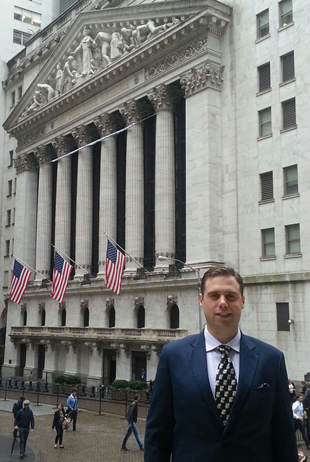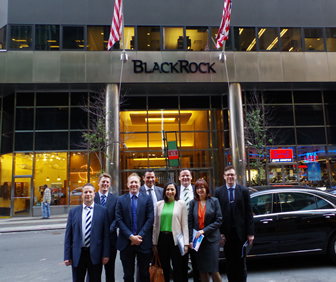-
Get the latest news! Subscribe to the ifa bulletin

Join ifa Editor Aleks Vickovich as he travels to New York with Implemented Portfolios to investigate what Aussie advisers can learn from the US post-GFC experience.
Day five: who do you think you are?
In many ways, FOFA pulled back the curtain, revealing the layers of commission and kickback that powered the engine of Australian ‘financial advice’ for decades. But despite the removal of some forms of conflicted remuneration, the reality is that most Aussie advice firms have not truly embraced transparency about what they do and who they are.
The reality is that – regardless of the quality of advice services provided (much of which is, admittedly, very high) – most advisers are not, deep down, investment experts. They don’t stock pick or really believe the value of what they do lies in the monetary returns their client portfolios attract, and they largely outsource the portfolio construction – whether to a third party or to a wrap or platform.
And yet, while most advisers are truly expert at the human interaction and coaching piece – as opposed to the geeky stuff that underlies it – and will confirm (off-record) that that is what they feel they really do, it is rarely reflected in their business or understood by their clients.
So while the curtain has been partly peeled back, many have only stuck out a few toes, yet to commit to full frontal nudity.
On a macro level, the American wealth management industry is no more transparent. In fact, with investment banks among the largest in the world and a lobbying industry that dwarfs any other, it could be argued that consumers in the US are even more confused than ours when it comes to ownership, independence and fiduciary duties.
But over the last four days of intensive interviews and workshops, it has become abundantly clear that at practice level the firms that are really succeeding in the post-GFC world are those that can clearly identify what they do and, perhaps more importantly, what they don’t do.
As advisers have fled the restrictive and bureaucratic institutional wire-houses and set up as RIAs – sound familiar anyone? – they have gravitated naturally into two camps: asset managers and asset gatherers.
The consultants, executives and client-facing practitioners I have spoken to this week have been unanimous in their conviction that those who have truly self-evaluated their skills and client proposition are the advisers that will prosper long-term.
Like De Niro in Taxi Driver, these new-age advisers have taken a long, hard look in the mirror and – once the 'gatherer v. manager' epiphany has been reached – the practice management, client retention, marketing and revenue benefits have flowed.
But, at the same time, this value proposition revolution has largely been contingent upon the rise of the RIAs i.e. without structural independence and control, the task of becoming a successful asset manager or asset gatherer will be more thorny, if not doomed outright.
So for those that are willing to ask serious questions about your strengths and limitations, you may as well go the whole hog and ask who you really work for and where their allegiance lies.
To be blunt, can you really be the adviser you want and need to be within a dealer group or structure that doesn’t fully allow you to control your own destiny?
The last few years of headlines and inquiries have resulted in an emerging awareness among consumers about the secrecy and lies within Australian financial advice.
While Europeans may caricature Americans as unsophisticated, perhaps their culture of honesty and simplicity – at least at the intermediary level – may just be what the doctor ordered.
This is the final entry of the ifa American Diary. An extended feature version will appear in the November edition of ifa magazine.
Day four: Rise of the Robots
You only have to stand in front of the overwhelming neon of Times Square for a few seconds to witness America's devotion to the technology business. From NASA’s feats in space to its social media revolution, this country innovates and adapts to tech trends seemingly far more quickly and successfully than others.
Australia, by contrast, is a country where the National Broadband Network is more about job creation for engineers and photo opportunities for hard hat-wearing politicians than it is about world-leading tech service provision.
And yet, the emergence of automated, technology-based asset allocation tools – or ‘robo-advisers’ – has both Australian advisers and their US RIA counterparts more than a little nervous.
Meeting yesterday in the relaxed offices of RIA firm Lenox Wealth, it became clear the rise of robo-advisers is consuming the debate within the RIA community and the associated trade press.
“A lot of RIAs are really watching this closely and some are pretty worried,” Lenox’s practice principal told us.
While there are only a handful of Aussie entrepreneurs actually developing and releasing robo-advice offerings to the market – as opposed to just talking about it – the US is well and truly alive.
Bank of New York Mellon’s Pershing Advisor Solutions (PAS) business – which provides custody and consulting services to the investment management industry – is receiving several phone calls each week from RIA firms looking to get into the robo-advice game, with two or three formal venture proposals hitting the Pershing desks each month.
Speaking to us from the bank’s sprawling Jersey City offices, PAS vice-president and technology consultant Robert Teaney tells us there are at least 10 different robo-adviser models emerging – with an undetermined number of actual websites or providers – anticipating that “in twelve months there will be even more”.
These tools are being developed not only by tech entrepreneurs but by RIAs at the coalface, despite the fact that the majority of RIAs – like Aussie advisers – are either unaware of the robo trend or have their heads deep in ostrich-mode.
But for PAS director Patrick Burke, the rise of robo-advisers is “definitely not a threat but an opportunity” for both advice firms as well as the service providers to advisers.
The innovations developed by the robo-advice entrepreneurs are being closely monitored by the RIA market and, where possible, at practice level – from client data segmentation tools to greater social media-esque ‘sharing’ and ‘liking’ functions and more efficient (and service-oriented) reporting capacity.
For Burke, it is the robots who should be more worried about the enduring need for personal advice.
“Robo-advisers are fine for when the markets are up,” he says. “The big question is what happens when they are down – will we see people realise what they need is more tailored, traditional advice?”

Day three: Service sensitivity
For three generations the Marrocco family have worked the paper-covered floors and marbled hallways of the New York Stock Exchange. The family’s current custodian of the tradition, Robert J Marrocco – a fast-talking associate with the NYSE’s global index and exchange traded products division (and occasional tour guide) – represents the best of America’s devotion to customer engagement and service. The need to provide superior service and fight for every dollar is deeply embedded within the US business culture, and – it could be argued – is largely responsible for the Carnegies and Rockefellers and the rise of America as a global superpower.
 As we were eagerly shepherded through the stock exchange’s security barriers, Marocco probably should have been focusing on the listing of a Citi group exchange-traded note (happening today) or the imminent listing of Chinese tech giant Alibaba slated for later this week (and seemingly the talk of the town right now). But instead, he took considerable effort to escort a motley band of Australian advisers (and hangers-on like myself) through the warren-like neo-classical building, generous with his anecdotes and time, while high-fiving various brokers, traders and janitors and extolling the great feats of American capitalism.
As we were eagerly shepherded through the stock exchange’s security barriers, Marocco probably should have been focusing on the listing of a Citi group exchange-traded note (happening today) or the imminent listing of Chinese tech giant Alibaba slated for later this week (and seemingly the talk of the town right now). But instead, he took considerable effort to escort a motley band of Australian advisers (and hangers-on like myself) through the warren-like neo-classical building, generous with his anecdotes and time, while high-fiving various brokers, traders and janitors and extolling the great feats of American capitalism.
Pure Wall Street, without the wolf.
But Marrocco’s customer service philosophy is not confined to New York’s financial district.
According to our host for the day, Kevin W Quigg, global head of ETF Strategy at State Street Global Advisors – an equally gracious and friendly American – leading service is the new alpha for registered investment advisers (RIAs) across the country.
Since the GFC, the US Securities and Exchange Commission – a scarier, better-funded ASIC – has focused its attention largely on the “wire-houses” i.e. household name financial conglomerates that are somewhere between investment banks and institutional dealer groups in the Australian context. As a result many of the wire-house broker-dealers – kinda like a cross between stockbrokers and product-minded advisers – left the safety of the institutional brands to register as RIAs and set up small business fee-for-service advice firms. RIA numbers have risen significantly since.
The great majority of these RIAs – which many over here describe nonchalantly as “independents” without any of the panic and controversy that word can engender back home – have flourished over the last few years, according to Quigg, and key to their growth has been a significant shift in value propositions.
“Clients want customised service, not customised investment solutions,” Quigg says. “They are sensitive to poor service not poor performance.”
These new breed RIAs have moved away from a myopic focus on investment returns, judging themselves and their worth not by portfolio results and market trends but by client satisfaction levels and the percentage of goals reached.
As the Australian industry also embraces service fees – albeit as a result of legislative intervention – the customer service culture that pervades all levels of American life may offer some inspiration.
However, judging by the happiness levels of New York cabbies (or lack thereof) a business based purely on tips may be a bridge too far.

Day two: The flight to liquidity
As the members of the Implemented Portfolios Study Tour were deep in a spaghetti-induced slumber, our Australian colleagues were receiving the news that van Eyk Research has gone into voluntary administration.
Back in August, ifa sister title InvestorDaily broke the news that van Eyk had written to clients informing them of temporary suspensions on some of its Blueprint series funds due to underlying investments “ceasing to be a liquid scheme as defined by the Corporations Act”.
So for many observers the announcement came as no great shock.
But despite being a longstanding critic of traditional managed funds, IP director Santi Burridge did not wake up to the news with a smile.
“I’m very disappointed about what has happened at van Eyk – I really feel for the business and the shareholders and all the people affected by it, but at the same time it just highlights the inefficiency and problems of the managed fund structure,” he says. “Investors should demand liquidity – it should be non-negotiable.”
 We spent the day at the East 52nd Street headquarters of BlackRock, the “world’s largest asset manager”. Through a number of on and off the record meetings with BlackRock operatives from across the business, what became clear was that our American cousins have embraced exchange-traded funds in a major way.
We spent the day at the East 52nd Street headquarters of BlackRock, the “world’s largest asset manager”. Through a number of on and off the record meetings with BlackRock operatives from across the business, what became clear was that our American cousins have embraced exchange-traded funds in a major way.
Among a number of statistics jumping forth from some very slick-looking slides, one really stood out: BlackRock’s iShares ETF business is now 40 per cent larger than the entire ETF market was only a few years ago.
For Katharine Earhart, the San Francisco-based director of the iShares Connect Program– a service provider to the growing sector of “ETF Investment Strategists” – the GFC was instrumental in the growing adviser appetite for exchange-traded funds.
“A lot of [investment advice and wealth management] firms saw what happened in ’08, and saw ETFs as an easy way to implement a downside protection strategy,” she tells ifa.
“A lot of advisers were caught off guard and weren’t able to move client money out of the market and into cash as quickly as they wanted to.”
As well as the yearning for liquidity, Burridge lists the client protection mechanisms offered by ETFs – relative to other structures – as another key factor driving the ETF trend.
“With an ETF, the assets are owned by the investors, so if something goes wrong, the investors will get their money back, as long as the exchange is open; so you don’t get the redemption suspensions issue we saw with van Eyk,” he explains.
“The underlying message is that [with managed funds], when you need control you don’t have any.”
In a short few years, America has seen a proliferation of ETF Investment Strategists – usually former client-facing advisers or fund managers that specialise in majority ETF portfolios – with more than 115 firms working with BlackRock alone, representing more than 600 investment strategies.
Having been acquainted with the rise of these new investment professionals for a number of years, Burridge anticipates Australia will also see greater demand for “third-party managers” as structures like ETFs become more popular, though admits it requires a mentality shift for many advisers.
If the American story is anything to go by, van Eyk’s administration could just be a catalyst.
Day One: Re-examining tall poppies
West Londoners are internationally regarded for their cynicism and acerbic wit, but Treysta head of wealth management Mark Nagle has developed a healthy case of ‘new world’ optimism during his decades Down Under. America’s unbridled enthusiasm for business and for self-conscious self-improvement is one of the reasons he has been attending the Implemented Portfolios Study Tour for years.
“There is so much we can learn from the US,” he says over breakfast coffee and “French donuts” (croissants). Reflecting on findings picked up over previous trips with Santi Burridge and the team at IP, Nagle says there are a number that are really relevant to Aussie advisers.
 In particular, he lists the “redefining of performance from a financial benchmark such as the ASX200 to a benchmark based on client objectives” as well as the increasing popularity of US advisers tending to categorise themselves as “asset gatherers” or “asset managers”.
In particular, he lists the “redefining of performance from a financial benchmark such as the ASX200 to a benchmark based on client objectives” as well as the increasing popularity of US advisers tending to categorise themselves as “asset gatherers” or “asset managers”.
This second trend is especially pertinent, given recent Investment Trends data that found identifying and articulating value propositions is still so front of mind for many Aussie advisers.
Over the next five days of meetings – with both the Big End of Town and advisory firms at the coal face – I want to unpack these findings, but I’m also interested in investigating an altogether different dichotomy: the changing advice consumer relationship with big and small business.
While it may sound alarmist to draw parallels between Australia’s recent experience with the Commonwealth Bank financial planning scandal and the Murray Inquiry and the undeniably more widely-felt US experience with the GFC, I don’t think it is an exaggeration to say that the ground back home is shifting.
Led by increased media and parliamentary scrutiny, Aussie consumers are twigging to the inherent problems with institutional product distribution masked as objective advice, and the push to structurally separate the two is growing more popular by the day.
In the States, a wave of post-GFC regulation culminating in the Dodd-Frank reforms has opened eyes to the notion that the brands adorning the mastheads of New York skyscrapers may not have always acted in consumers’ best interests. The public's cottoning on to the role played by the investment banks, fund managers and research houses in allowing the sketchy sales climate leading to the GFC to proliferate has provided a backdrop for American advisers to re-evaluate who they really work for and what value they offer.
 If America – with all its conviction about the inherent goodness of capitalism and growth – can start questioning its household name financial brands, then surely those of us that subscribe to at least an element of tall poppy syndrome can start to apply more pressure.
If America – with all its conviction about the inherent goodness of capitalism and growth – can start questioning its household name financial brands, then surely those of us that subscribe to at least an element of tall poppy syndrome can start to apply more pressure.
That shift in power from the owners of the means of production to consumers and their trusted advisers is what I am here to investigate, as well as any other trends that become apparent.
But since Nagle and I are both Queens Park Rangers fans and the bars of Midtown are just opening, we have a different kind of study to attend to.
Never miss the stories that impact the industry.